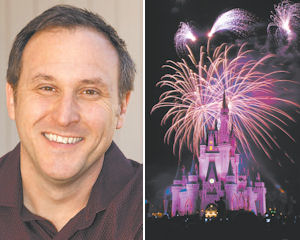Scott Trowbridge Vice President of Research and Development, Walt Disney Imagineering 1) How much of a presence does Parks and Resorts have in the San Fernando Valley region? While Walt Disney Parks and Resorts continues to expand globally, Burbank/ Glendale remains our business and creative headquarters. Walt Disney Imagineering, the worldwide creative design and delivery group, employs people working in over 140 different disciplines from computer scientists to sculptors, robotic engineers to architects. 2) What’s your favorite Disney park and why? And how about your favorite Disney attraction? That’s like asking who your favorite child is! It’s easy to find good reasons to claim each of them as a favorite. Of course, as one of the folks dreaming up the ideas of what’s next, I’m most excited by what we have in development and can’t wait for our guests to experience what we’re working on. 3) What’s the best part of working for this part of the organization? Imagineering uniquely demonstrates Walt Disney’s belief that if you can dream it, you can do it. The amazing talent, desire for collaboration and creatively-led vision of Imagineering not only affords us the capability to create whatever we can dream up, but it also obligates us to continue to push ourselves even further on behalf of our guests. 4) What’s the single biggest challenge you face running advanced development for Walt Disney Imagineering that keeps you up at night? Because our products have long development lead-times, years in many cases, we have to be very good at predicting the future. For us to deliver a meaningful and novel experience, we need to develop emerging technologies, identify creative and behavioral trends, forecast where those trends might lead, and integrate that thinking into experiences that might not be finished for many years. It’s a difficult challenge and a fantastic opportunity. Of course, foremost in all of that is the requirement for a strong story concept. Everything else exists to support the delivery of experience and story in a unique and compelling way. For example, interactivity, customization and always-connected experiences are just a few examples of technology and social trends that we are weaving into dynamic, entertaining and novel experiences. At the end of the day, however, we want all of that technology and effort to stay behind the scenes and let the story, experience and amazing service be the focus for our guests. How we do it behind the scenes remains part of that special Disney magic. Forget Disney characters, films — even cable and broadcast TV. Disney’s biggest driver of growth these days is thrill rides and hotel rooms. The Parks and Resorts division — comprised of 32,000 acres of land, 26,000 hotel rooms, 11 theme parks and soon to be four cruise ships — lately is generating the most growth in both sales and profits, outperforming all other segments of the company. Parks and Resorts grew 10 percent in revenue to $3.16 billion in the quarter ended Dec. 31, 2011, while the division’s profitability soared 18 percent, generating $553 million for the Disney conglomerate. The division owns and operates the Walt Disney Resort in Florida, the Disneyland Resort in California, a resort and spa in Aulani, Hawaii, the Disney Vacation Club, the Disney Cruise Line and Adventures by Disney, which takes families to non-Disney adventure destinations around the world. The division also owns significant stakes in Disneyland Paris, Hong Kong Disneyland Resort and the Shanghai Disney Resort. It also licenses and operates the Tokyo Disney Resort in Japan. The core of the company was, once upon a time, Disneyland, which opened in Anaheim in 1955. Since 1971, it’s been joined by the Magic Kingdom, Epcot, Disney’s Hollywood Studios and Disney’s Animal Kingdom — all in Florida, which is now much larger than its California counterpart. In California, the newcomer is California Adventures, opened in 2001. The new 12-acre Cars Land, inspired by the animated film Cars, is scheduled to open this summer. Other additions to come include the new Avatar attraction in Orlando’s Animal Kingdom, a new theme park in Shanghai, scheduled to open in five years, and a the fourth cruise ship, the Disney Fantasy — a 130,000-ton ship with 1,250 staterooms—scheduled to take its maiden voyage March 31. The division was formerly headed by current Disney CFO James A. “Jay” Rasulo, who has received much of the credit for expanding Parks and Resorts from $6.5 billion when he assumed the post to nearly $11 billion today. Rasulo, however, received some criticism for too much standardization among the Disney properties. Some observers say it’s hard to tell the Orlando property apart from those in Paris and Hong Kong. Rasulo was promoted to executive vice president and chief financial officer in January 2010. His successor, Thomas Staggs, now oversees the completion of the many large projects started by Rasulo, including the enormous Chinese project, while boosting attendance and hotel room stays. While the division delivered strong growth in sales and profits in 2011, much of the growth depended on higher ticket prices and fewer discounted room nights. Attendance at the two big U.S. theme parks grew 3 percent in the latest quarter, while overall guest spending jumped 8 percent. The same was true for hotels: spending per room grew, but the overall occupancy — at least in the U.S — was flat. The numbers suggest that while guests are shelling out more money for their vacations, not as many are able to take that special Disney vacation as used to. — Judy Temes
